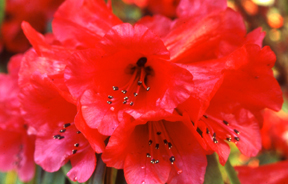
One of the classic species in the genus Rhododendron must surely be R. strigillosum. The large deep red flowers in early spring set against the characteristic whorl of dark green leaves with distinctly bristly petioles make this species a must for every collection.
Known in its native China as mang ci dujuan (“prickly rhododendron”), this species was first described in 1886 by the French systematist M. A. Franchet from material collected several years earlier in Sichuan, China. It was introduced into cultivation by Ernest Wilson (W#1870) in 1904 during his plant hunting days as an employee of the Veitch Nursery.
R. strigillosum is typically a plant of open shrubby thickets and woodlands. It occurs at elevations of 7,000 to 11,000 feet (2100 to 3400m) in the mountainous regions of southwestern China, specifically the Provinces of Sichuan and adjacent northeastern Yunnan. I was able to observe this species many times during the fall of 1995 while exploring that region of China. It grew as a large shrub or small tree up to 25 feet in height and often made quite an impressive specimen. Unfortunately, due to the season, we did not see any flowers, but I was quite taken with the overall quality and beauty of the foliage. We noted that it grew in association with a wide variety of plants including several rhododendrons, maples (Acer spp.), Viburnum spp., and hollies (Ilex spp.), to name but a few. A sampling of the rhododendrons found growing with R. strigillosum in the areas visited would include 1) pingianum, argyrophyllum, rubiginosum, racemosum, and augustinii 2) lutescens, argyrophyllum, huianum, asterochnoum, and the closely related and extremely rare ochraceum 3) calophytum, longipes, and denudatum. The first two associations were observed in the fairly rugged mountainous country of southern Sichuan near the Yunnan border at 10,000 (3048m) and 9,300 (2835m) feet respectively. The third occurred at 8,500 (2590m) feet in the low hills of northeastern Yunnan.
R. strigillosum is a member of Subsection Maculifera (Subseries Maculiferum). It is probably most closely related to the species ochraceum and pachytrichum, the latter merging into strigillosum and probably hybridizing with it where the ranges overlap. These hybrids probably account for the reports of pink or even white-flowered forms of strigillosum. The taxon R. strigillosum var. monosematum (“R. monosematum”) is probably actually closer to pachytrichum and may benothing more than a natural hybrid arising where these two species occur together.
The distinctive foliage of R. strigillosum is easily recognized and at first glance can only be confused with that of the closely related R. pachytrichum. However, closer study will reveal the distinctive differences between the two. The lower leaf surface of R. strigillosum is typically covered with short glandular or branched hairs and will have a more or less bristly midrib. In contrast, the lower leaf surface of R. pachytrichum is typically smooth except for short hairs on (and sometimes near) the midrib. The petioles and younger branches of the former are also quite bristly-glandular (strigillose) while typically only tomentose (shorter, softer hairs) in the latter. The leaves of R. strigillosum are elliptic to oblanceolate in shape with a wedge-shaped to somewhat rounded base and a short sharp tip (cuspidate) at the apex. They are three (7.6cm) to six inches (15cm) in length and up to two inches (5cm) wide with a more or less recurved margin.
In early spring, the sticky flower buds open to reveal brilliant crimson, scarlet, or deep red flowers nestled beautifully on a whorl of dark green bristly leaves. Although the flowers appear in late February to mid-March here at the RSBG, they are relatively frost resistant and so escape serious damage most years to put on one of our most spectacular early exhibitions. The tubular bell-shaped flowers are up to 2.5 inches (6.35cm) long and occur in an inflorescence of eight to twelve flowers. The bright red color is nicely highlighted by the five black nectar pouches at the base of each flower for a truly spectacular floral display.
In cultivation R. strigillosum forms a large dense evergreen shrub often as wide-spreading as it is high. Being a plant of forests and thickets it prefers some protection from full exposure to the sun but is not really a difficult species to accommodate. We have found that the foliage tends to yellow if planted in too much sun. It grows splendidly for us exposed to the east in the partial shade of adjacent tall conifers. This species is relatively hardy (-5F [−20C] to -10F [−23C]) but the new foliage tends to emerge rather early, so it is best to avoid low areas or other frost pockets.
With its ease of culture and beautiful flowers, R. strigillosum is often used as a parent in Rhododendron hybrid breeding programs. Some very popular and well-known hybrids have arisen from crosses using this species including ‘Etta Burrows,’ ‘Grace Seabrook,’ ‘Matador,’ and ‘Taurus.’ A clone of this species with rich blood-red flowers received an Award of Merit when exhibited by Bodnant in 1923.
ACCESSIONS IN THE COLLECTION OF THE RSF:
1965/277 Leonardslee. Large red flowers.
1969/836 Lyons:Walker. Flowers red.
1973/269 Greig. Flowers a rather “bleached red”.
1973/270 Robbins. Large red flowers, a good form.
1973/271 Greig. Flowers bright red, a good form
1975/159 Greig. Large red flowers.
1975/178 Greig. Red flowers, a good form
1975/282 Nelson:Pierce. Red flowers
1976/081 Phetteplace:Berg. Red flowers, a good form
1976/222 Brodick:Berg. Blood-red flowers, one of our deepest clones.
1977/627 Greig. Red flowers.
1977/791 Crarae. Long crimson flowers.
1982/125 RBGE:Bender. Blood-red flowers, “Davidian’s favorite.”
1983/012 Greig. Rather poor crimson flowers.
1983/142 Caerhays.
1984/047 Strone. Deep red flowers.
1995/256 U. of CA. B.G. From seed collected in Sichuan, China as “var. monosematum.”
NOTE: We have also accessioned many new plants grown from seed collected in the wild. These young plants have yet to be fully evaluated but the striking foliage characteristics and very large, deep red flowers hold great promise for their horticultural potential.
REFERENCES CONSULTED
Chamberlain, D. F. 1982. A Revision of Rhododendron. II. Subgenus Hymenanthes. Notes from the Royal Botanic Garden Edinburgh. Vol. 39(2):
Cox, P. A. and K. N. E. Cox. 1997. The Encyclopedia of Rhododendron Species. Perth, Scotland: Glendoick Press.
Davidian, H. H. 1989. The Rhododendron Species. Vol. II. Portland, OR: Timber Press.
Hootman, S.E. 1995-2006. Unpublished field notes.
Rhododendron Species Foundation: Records – 1964 to present.
